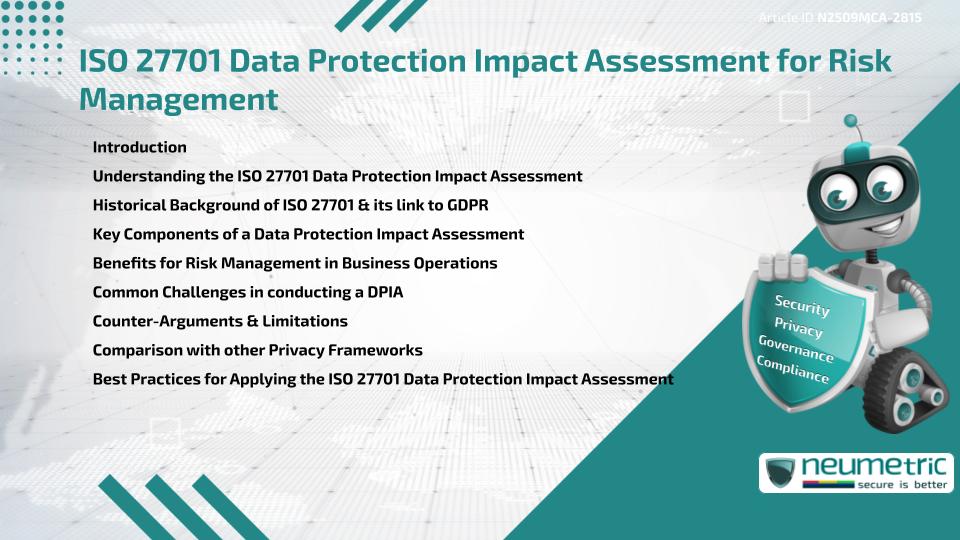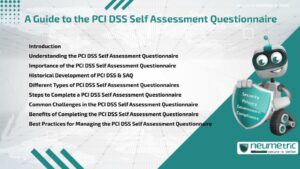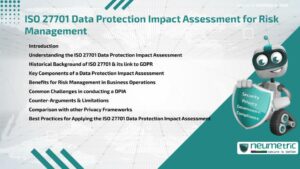Table of Contents
ToggleIntroduction
The ISO 27701 Data Protection Impact Assessment is a structured process designed to identify & minimise Risks related to Personal Data processing. As an extension of ISO 27001, ISO 27701 provides Organisations with a Framework to manage Privacy information effectively & comply with Data Protection laws. The Assessment helps businesses detect Vulnerabilities, address Compliance gaps & implement safeguards before Risks materialise. By integrating the ISO 27701 Data Protection Impact Assessment into Risk Management strategies, Organisations not only secure Sensitive Information but also enhance Operational Resilience & Stakeholder confidence.
Understanding the ISO 27701 Data Protection Impact Assessment
A Data Protection Impact Assessment [DPIA] is a methodical review of processes that involve Personal Data. Within the ISO 27701 Framework, it ensures that Data Protection measures align with organisational Risks & Regulatory requirements. The ISO 27701 Data Protection Impact Assessment guides Organisations through identifying high-Risk activities, analysing their potential impact & applying controls to mitigate Risks. It is particularly valuable for industries that handle Sensitive Information such as Healthcare, Finance & Technology.
Historical Background of ISO 27701 & its link to GDPR
ISO 27701 was introduced in 2019 as an extension to ISO 27001 & ISO 27002, addressing the growing importance of Privacy. Its design closely aligns with the General Data Protection Regulation [GDPR], which mandates DPIAs for high-Risk processing activities. By formalising the process within a global standard, ISO 27701 helps Organisations demonstrate Compliance with GDPR & similar laws worldwide. This historical link shows how the ISO 27701 Data Protection Impact Assessment bridges the gap between Cybersecurity & Privacy management.
Key Components of a Data Protection Impact Assessment
The ISO 27701 Data Protection Impact Assessment typically involves four (4) key steps:
- Identifying processing activities: Mapping Personal Data flows across the Organisation.
- Assessing Risks: Evaluating Threats to Data Confidentiality, Integrity & Availability.
- Mitigation measures: Implementing Technical, Organisational or Legal safeguards.
- Documentation & Monitoring: Recording outcomes & ensuring continuous oversight.
These components ensure that Privacy Risks are systematically addressed & integrated into Business Operations.
Benefits for Risk Management in Business Operations
Conducting an ISO 27701 Data Protection Impact Assessment brings significant benefits. It reduces the Risk of Data Breaches, ensures Compliance with Privacy regulations & helps avoid fines & reputational damage. From a strategic perspective, businesses gain deeper insights into their data processing activities, enabling smarter decision-making. Moreover, demonstrating Compliance through a Standardised Process builds Trust with Customers, Regulators & Partners.
Common Challenges in conducting a DPIA
Despite its benefits, businesses may face challenges when implementing the ISO 27701 Data Protection Impact Assessment. Identifying all data flows can be complex, especially in large or decentralised Organisations. Limited expertise & resources may hinder smaller companies from conducting thorough Assessments. Additionally, maintaining continuous Compliance requires consistent Monitoring & adaptation to new Risks, which can strain resources over time.
Counter-Arguments & Limitations
Critics argue that a DPIA, while useful, can become a bureaucratic exercise if not tailored to business needs. Over-reliance on standardised checklists may result in overlooking context-specific Risks. Furthermore, the ISO 27701 Data Protection Impact Assessment does not guarantee full Compliance with every regional Privacy law, as regulations vary worldwide. Instead, it should be viewed as a robust foundation that must be adapted to local legal Frameworks.
Comparison with other Privacy Frameworks
The ISO 27701 Data Protection Impact Assessment can be compared with Privacy Frameworks such as the European Data Protection Board guidelines & the NIST Privacy Framework. While these provide useful direction, ISO 27701 offers a certifiable & internationally recognised standard. Unlike region-specific regulations, ISO 27701 provides a broader approach that enables Organisations to align with multiple Regulatory environments simultaneously. This makes it especially appealing for global enterprises.
Best Practices for Applying the ISO 27701 Data Protection Impact Assessment
To apply the ISO 27701 Data Protection Impact Assessment effectively, businesses should:
- Conduct a thorough mapping of all Personal Data processing activities.
- Involve cross-functional teams, including Legal, IT & Compliance specialists.
- Tailor Risk Assessments to the organisational context rather than relying solely on templates.
- Establish regular Monitoring & Reviews to ensure ongoing Compliance.
- Provide staff training to embed Privacy awareness across the Organisation.
Adopting these practices ensures that the Assessment delivers lasting value & supports long-term Risk Management strategies.
Takeaways
- The ISO 27701 Data Protection Impact Assessment identifies & mitigates Risks in Personal Data processing.
- It aligns with GDPR requirements & other Privacy regulations.
- Businesses benefit through improved Compliance, Risk reduction & Customer Trust.
- Implementation challenges exist, especially for resource-limited Organisations.
- Tailoring & Continuous Monitoring are essential for success.
FAQ
What is the ISO 27701 Data Protection Impact Assessment?
It is a structured process within ISO 27701 to identify, evaluate & mitigate Privacy Risks in Personal Data processing.
How does the ISO 27701 Data Protection Impact Assessment support GDPR Compliance?
It formalises the requirement for DPIAs, ensuring that high-Risk processing activities meet GDPR obligations.
Is the ISO 27701 Data Protection Impact Assessment mandatory for certification?
Yes, Organisations seeking ISO 27701 Certification must demonstrate how DPIAs are conducted & integrated into operations.
What industries benefit most from a DPIA?
Industries handling Sensitive Data such as Healthcare, Finance & Technology gain the most value from conducting DPIAs.
Does completing a DPIA guarantee Compliance?
No, while it greatly reduces Risks, businesses must also meet region-specific legal requirements.
How often should a DPIA be reviewed?
It should be reviewed regularly, especially when new technologies or processes are introduced that affect Personal Data.
What are common mistakes in applying for a DPIA?
Over-reliance on checklists, lack of cross-department collaboration & failure to update assessments over time are frequent mistakes.
Need help for Security, Privacy, Governance & VAPT?
Neumetric provides organisations the necessary help to achieve their Cybersecurity, Compliance, Governance, Privacy, Certifications & Pentesting needs.
Organisations & Businesses, specifically those which provide SaaS & AI Solutions in the Fintech, BFSI & other regulated sectors, usually need a Cybersecurity Partner for meeting & maintaining the ongoing Security & Privacy needs & requirements of their Enterprise Clients & Privacy conscious Customers.
SOC 2, ISO 27001, ISO 42001, NIST, HIPAA, HECVAT, EU GDPR are some of the Frameworks that are served by Fusion – a SaaS, multimodular, multitenant, centralised, automated, Cybersecurity & Compliance Management system.
Neumetric also provides Expert Services for technical security which covers VAPT for Web Applications, APIs, iOS & Android Mobile Apps, Security Testing for AWS & other Cloud Environments & Cloud Infrastructure & other similar scopes.
Reach out to us by Email or filling out the Contact Form…





